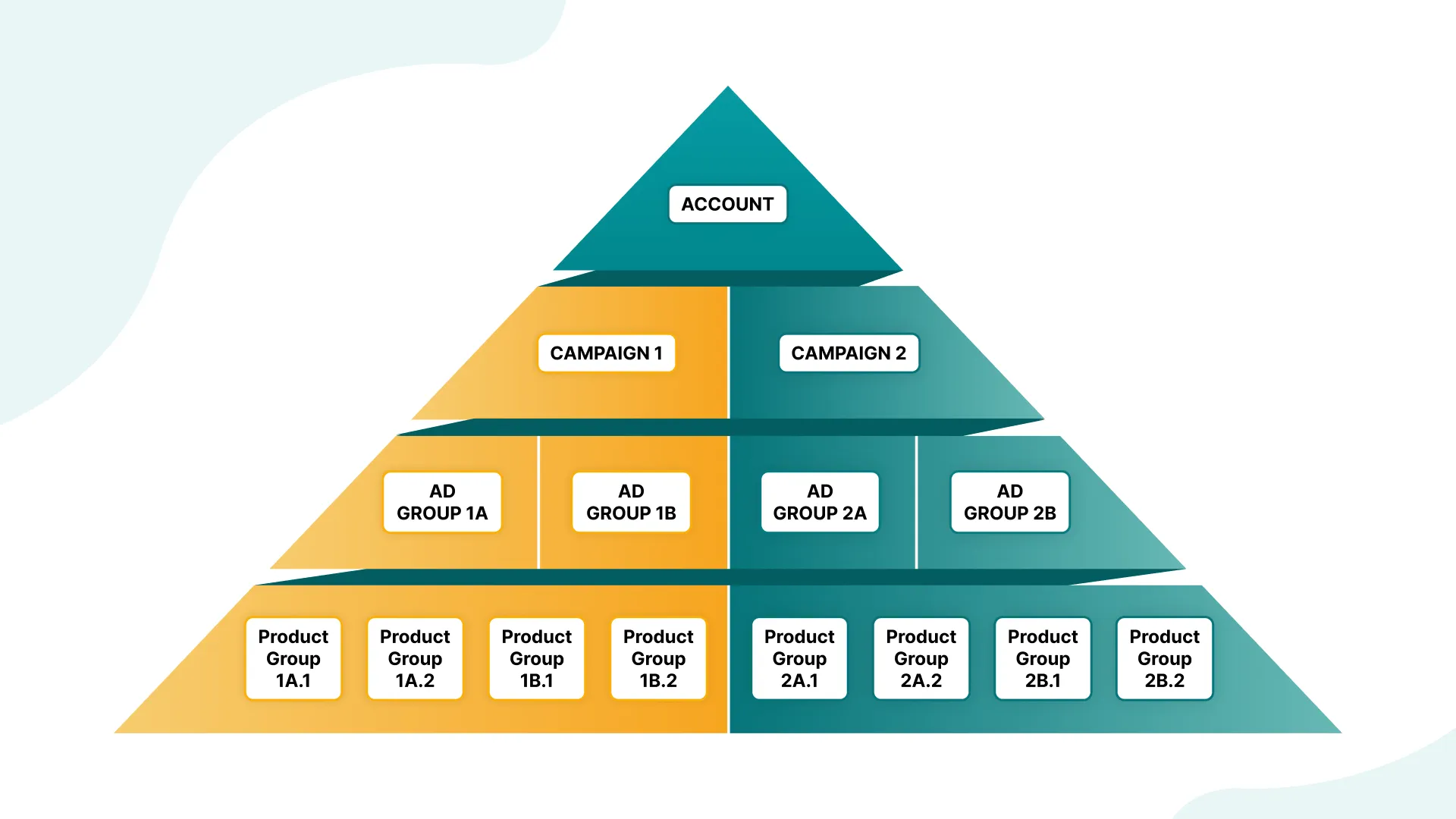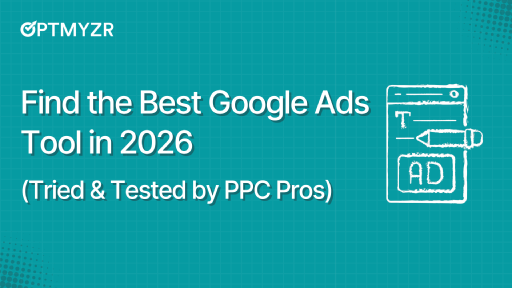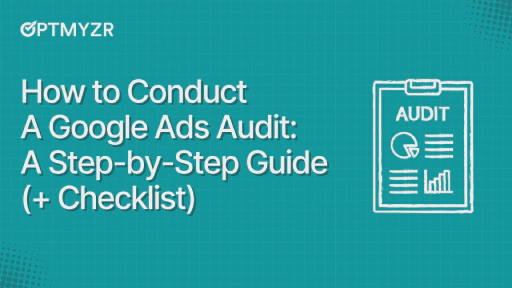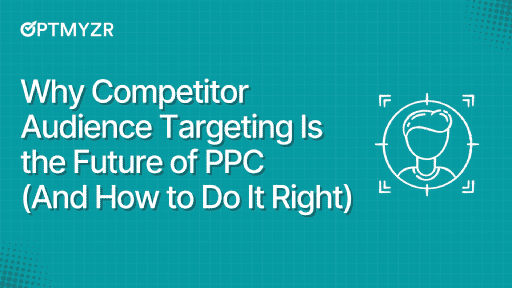Sales and profit are the ultimate goals of ecommerce and retail advertising. For brands and agencies pursuing these objectives through Google Ads, Shopping campaigns offer greater control, structure, and reporting visibility than Performance Max.
While Google continues its shift toward Performance Max, many advertisers still find Standard Shopping campaigns essential—particularly those who prioritize control, transparency, and margin-aware strategies.
Whether you’re switching back from Performance Max or building from scratch, your Shopping campaigns’ structure significantly impacts your ability to get the most out of your ad spend. Cobbling together products with varying profit margins, levels of demand, and supply chain constraints is a recipe for budget under-optimization.
Let’s go through:
- Structural components of Google Ads Shopping campaigns
- Six ways to build a Shopping campaign
- Best practices for Shopping campaign structure
- Campaign management and optimization advice
The basics of campaign structure for Google Shopping ads

Shopping campaigns in Google Ads feature a four-tier hierarchy of elements:
- Campaigns: A collection of assets with a shared budget and targeting parameters
- Ad groups: A group of related advertising assets oriented around what people are
- searching for
- Product groups: Collections of for-sale products with a shared set of attributes
- Products: The individual items in your catalog
Each level allows you to specify and modify certain parameters, which I’ll explain in the sections below.
Campaign level
Campaigns cover settings that apply across ad groups, product groups, and products. These include:
- Goals, such as a ROAS or CPA target
- Budget
- Bidding strategy
- Interest-based targeting
- Location targeting
- Language
If you’re using smart bidding strategies like Target ROAS (tROAS) or Target CPA (tCPA), it’s important to set realistic performance goals. These strategies rely on high-quality conversion data and sufficient volume to optimize bids effectively. Without enough signals, even the most sophisticated bidding can fall short.
Ad group level
Google allows you to create multiple ad groups in Shopping campaigns. At this level, negative keywords (which filter out irrelevant queries, intents, and audiences) are crucial.
Negative keywords are one of the biggest advantages of Shopping campaigns. With Performance Max, your options are limited to account-level negative keywords, campaign-level brand exclusions, and a cumbersome form to manually request campaign-level negative keywords.
This limits your ability to sculpt traffic, requiring you to absorb more irrelevant visitors in order to get incremental conversions, affecting overall campaign profitability if your budgets are constrained.
To avoid waste, it’s critical to regularly audit your campaigns for irrelevant queries or expensive terms that aren’t driving performance. Keeping your negative keyword lists fresh helps your Shopping ads stay aligned with buyer intent. Tools like Optmyzr’s Rule Engine, specifically the Search Terms scope, can automate this process, helping you spot and exclude underperforming queries by analyzing aggregated performance across match types and keywords within each ad group.
Product group level
Product groups are collections of individual products that sit within an ad group. There are multiple ways to group products into categories and subcategories. The two broad approaches use:
- Product feed attributes (e.g., brand, product type, color)
- Business data (e.g., profit margin, bestsellers, seasonal availability)
Product grouping lets you exercise granular control over bids, keep campaigns profitable, and prioritize your most relevant and in-demand products.
By creating custom labels and using them to build product groups, you can align your bids and budgets more closely with your business goals, whether that’s promoting high-margin items, seasonal collections, or clearance stock.
Some advertisers also implement dynamic grouping strategies, where products are automatically moved between groups based on real-time performance or inventory levels. This helps ensure that campaigns remain agile and focused on what’s working.
Shopping campaign priority levels
You can assign your Shopping campaigns one of three priority levels: high, medium, and low. These priority levels govern which campaign enters the auction for a query and allow you to create multiple campaigns for the same products.
Campaign priority is a powerful tool for query sculpting—controlling which campaign wins a particular search query and ensuring the right message or bid is applied at each funnel stage.
Use priorities to build a tiered campaign strategy:
- High priority + low bids: Ideal for broad, awareness-phase searches. Capture upper-funnel traffic cost-effectively.
- Medium priority: Target branded queries or comparison-stage shoppers.
- Low priority: Reserve for high-intent, bottom-of-funnel searches. Bid more aggressively here to maximize conversions.
This setup allows you to allocate budget and bid intensity based on purchase intent, optimizing efficiency across the full customer journey.
6 ways advertisers set up their Google Shopping campaigns
There’s no right or wrong way to set up a Shopping campaign; only what works for your account’s budget, business goals, and available resources.
Here are six common tactics to consider when building your next ecommerce or retail campaign in Google Ads:
- Single campaign, single ad and product group
- Single campaign, multiple ad and product groups
- Two or three campaigns using campaign priorities
- Multiple campaigns, multiple ad and product groups with query sculpting
- Performance-based approach (ROAS/CPA/profit margin)
- Groups of individual products (GRIP)
Single campaign, single ad and product group
Suitable for brands selling a single product line with similar pricing, such as flavored sparkling water
- Works well for accounts with limited budgets and resources
- Difficult to classify and track product performance for larger catalogs
- Tough to customize bidding and negative keywords to individual SKUs
💡Pro Tip: Split traffic using search term reports—labeling queries as low-intent vs. high-intent, to improve efficiency, even for smaller catalogs. This allows tighter control over spend and more relevant ad targeting |
Single campaign, multiple ad and product groups
- Good for brands with a single product line with wide pricing variety, such as footwear
- Allows for more variation and product grouping based on factors other than sale price
- Requires additional negative keyword management
- Difficult to increase spend on more favorable products
- Dynamic pricing tiers can help respond more quickly to market changes and support smoother budget pacing across varied product categories.
2 or 3 campaigns using campaign priorities
- Allows accounts limited by the previous structures (single campaign, mentioned above) to exercise more control over budget allocation, making it good for brands with limited but not singular product lines
- Priorities help you tell Google which campaign to favor for an auction
- Use high priority campaigns for low-intent, broad searches; medium for mid-funnel or branded queries; and low for high-intent, product-specific searches where ROAS is the goal
- Typically requires a higher budget than previously listed strategies
Multiple campaigns, multiple ad and product groups with query sculpting
- Ideal for mass retailers, resellers, or accounts with a wide variety of product types and brands
- Allows for tighter budget controls but requires additional monitoring
- Query sculpting uses negative keywords and priorities to drive traffic to the desired campaigns
- Challenging to maintain without automation when product feed values change, inventory and procurement fluctuate, and product lines are introduced and discontinued
- Prone to risks such as overspending and inefficient targeting when not monitored adequately
Automation tools are essential here—especially for maintaining negative keyword lists and adjusting campaign priorities dynamically to keep your sculpting strategy aligned with current inventory and performance
Performance-based approach
- Suitable for advertisers that need to exercise budgetary control over Shopping campaigns
- Incorporates CPA/ROAS targets and product grouping based on traits like production cost, contribution margin, etc.
- Allows you to allocate budget to the best-performing products
- Requires trial and error to find the optimal CPA/ROAS target
- Difficult to build and maintain without automation
Margin-informed bidding—where smart bidding strategies are guided by live profitability data—helps ensure you’re not just chasing conversions but prioritizing the ones that actually drive returns. This approach is especially valuable for ROI-focused structures where every ad dollar needs to pull its weight
Groups of individual products
- Limits products to one per product group for maximum control over bids
- Ideal for accounts with single-digit SKUs
- Viable way to test new catalog entrants and uncover performance metrics
Read more: 3 Google Shopping Campaign Examples You Can Copy Now
Best practices for building Google Shopping campaigns
Now that you’ve chosen a structure for your Shopping campaign, these industry-standard tactics will help you shape traffic and keep campaigns organized:
- Product grouping
- Merchant feed audit and optimization
- Budget allocation and bid strategy
- Negative keyword management
- Conversion tracking
- Audience tracking
Before you get started, remember: A best practice is only ‘best’ if it serves you. For the greatest results, use the theory behind these tactics but adapt them to your specific circumstances.
Product grouping
Organize your product groups based on what works for your business. You might use feed attributes (such as brand and color) to target queries that include those elements. Other effective strategies include grouping products by category or subcategory, bundling bestsellers to move inventory faster, or consolidating items with similar margins to support your bottom line.
For even more precision, build product groups using custom labels tied to dynamic data like profit margin, seasonality, and stock levels.
Tools like Shopping Campaign Management can automate this process—whether you’re setting up Standard or PMax campaigns—by syncing to your Merchant Center and recommending structure based on performance or feed attributes. This ensures your campaign structure always reflects real-time business needs.
Organize your product feed based on performance and build smarter campaigns:
Merchant feed audit and optimization
Product feeds are the lifeblood of your Shopping campaigns. Organized feeds make money, while incomplete or messy ones cost money.
It helps to periodically review your feed for issues, such as:
- Excessively long product titles
- Products with missing attributes (especially critical ones like the GTIN)
- Pixelated or unattractive product imagery
Clean up your source file to keep your campaigns error-free. Since feeds directly impact what gets shown (and how well it performs), ongoing audits are quite essential.
Optmyzr’s Shopping Feed Audit tool helps you stay ahead of common issues by automatically scanning your Merchant Center feed and flagging missed opportunities like disapproved products, missing data, and weak product group structures. The built-in dashboard widget gives you a quick view of feed health, so you can catch problems early.
For deeper monitoring at scale, the Rule Engine lets you set up proactive alerts and automated actions tied to feed quality, disapprovals, or underperforming groups—ensuring your campaigns stay efficient and aligned with your business goals.
Budget allocation and bid strategy
Managing your money well is critical in all forms of advertising, but particularly when selling physical goods on a comparison shopping platform like Google Ads.
- Brands can succeed with Shopping ads on Google, whether they spend $5,000 a month or $50,000 a day. The key is to structure your campaigns to suit your budget. For example, a modest budget spread across multiple campaigns with multiple product groups creates internal competition and limits your ability to enter enough auctions to reach profitability.
- Choose a bidding strategy that aligns with your business needs. Shopping campaigns offer granular control over structure, but Smart Bidding can often outperform even the most skilled human advertisers. If you can only afford to spend a certain amount to make a sale, using a CPA target provides Google with a clear constraint.
- For more margin-driven control, consider margin-informed bidding: use custom labels to inject profit data (like contribution margin or cost) directly into your campaign setup. This allows Smart Bidding to optimize not for ROAS alone, but for actual profitability—helping you prioritize ads that generate the best return in real time.
- There is so much outside the ad account that affects performance and profitability. Always account for factors and real world events that influence supply and demand, such as seasonality and spending patterns. Be aware of your target audience, their needs, and their mindset.
Negative keyword management
Adding unwanted or irrelevant search terms to the negative keyword list for an ad group prevents all the associated products from showing up for those searches. Remember that negative keywords use the same match types as positive ones (broad, phrase, exact), so use the correct format for the match type you want to prohibit.
To keep your campaigns efficient and your spend clean, make it a habit to review search queries regularly. This helps you catch expensive or irrelevant terms that may be slipping through. Update your negative keyword lists accordingly and refresh your SKAGs (Single Keyword Ad Groups) to reflect evolving trends and product performance.
Conversion tracking
If the product feed is the beating heart of a Shopping campaign, then conversion tracking is its mind. It’s critical that you choose the right conversion actions (both micro-conversions, like cart additions, and final conversions, like purchases) and that you track them correctly.
Without these in place, your account will register and learn from incomplete or inaccurate data, causing it to optimize in the wrong direction for the wrong outcomes. Using an algorithmic layer like Smart Bidding will amplify these unwanted consequences by several orders of magnitude.
That’s why it’s essential to validate your tracking setup end-to-end. Regularly audit for pixel accuracy, attribution delays, and consent-mode consistency to ensure that Smart Bidding has a clean, reliable foundation to optimize from. Even small gaps in data capture can derail campaign performance.
Audience tracking
Use this setting if you’d like to target specific audiences, such as remarketing lists of people who’ve visited your website before. Audience tracking will then let you show up for searches from people who’ve already shown some level of interest in your brand or products.
To improve bidding precision, segment your audiences by customer lifecycle stage—from new visitors to cart abandoners to repeat purchasers. This allows you to assign more appropriate bids based on where users are in their journey.
Also take advantage of dynamic remarketing in Shopping, which pulls in product-level data to show users the exact items they viewed or left in their cart—boosting relevancy and increasing the chance of conversion.
Read more: 12 Best Practices to Optimize Google Shopping Campaigns
Faster, easier, error-free shopping campaigns with Optmyzr
Choosing the right campaign structure is important, but it’s still only one part of running a solid Google Ads shopping program. Maintaining a healthy feed, filtering out low-quality queries, and keeping campaigns synced with inventory are just as important to success.
Keeping up with the flux in your accounts and feeds can get overwhelming. That’s without factoring in multiple accounts and feeds, and additional campaign types and platforms to manage.
Optmyzr gives you full control over your Shopping campaigns. Automate maintenance and monitoring tasks with freedom and flexibility, while enjoying the full visibility and total control that ad platforms are taking away from you.
- Keep campaigns up to date with inventory and feed changes. These changes are crucial yet daunting to keep track of manually, particularly when using a performance-based structure. Optmyzr allows you to sync your feed and automate campaign maintenance. Automatically move products from one campaign to another based on performance changes, where doing so manually for each product is practically impossible yet critical to maintaining campaign strategy.
- Quickly find and fix product feed errors and product disapprovals. Audit and optimize your merchant feed and disapproved products that limit the visibility and auction-worthy status of your products.
- Simplify search query management and traffic sculpting. Review search queries and add negative keywords with a click. No more sifting through multiple tabs and reports. Handle all your keyword and query management from one window in Optmyzr.
- Find the ideal ROAS or CPA target. Trial and error is inescapable, but Optmyzr minimizes the hassle. Make target adjustments and know immediately when performance begins to decline so you can roll back to the sweet spot.
- Reduce wasted ad spend. Spend money where you’ll make money. Automate a variety of actions for expensive product groups, including reducing bids and pausing ads altogether.
To see how we can support your advertising goals and business needs, speak to an Optmyzr expert or start a 14-day free trial.
People also ask
Q. What’s the best structure for a small product catalog?
A. For smaller catalogs, a single campaign with one or a few ad and product groups is usually sufficient. You can simplify setup while still exercising control by using search term reports to segment traffic by intent level—helping you tailor bids for low- vs. high-intent searches. Even small catalogs benefit from this layered approach to maintain efficiency and relevance.
Q. Can I still use Shopping Campaigns alongside PMax?
A. Yes. While Google is moving toward Performance Max, Standard Shopping campaigns remain valuable, especially for advertisers who prioritize manual control, budget segmentation, and negative keyword management. Tools like Optmyzr’s Shopping Campaign Management support both formats, allowing you to keep them in sync and maintain a unified strategy.
Q. How do I keep my shopping structure up to date as my inventory changes?
A. The key is automation. Manually shifting products between campaigns based on performance or inventory changes is time-consuming and error-prone. Tools like Optmyzr’s Shopping Campaign Management allow you to automatically restructure campaigns, sync with your Merchant Center, and dynamically adjust product groups as conditions evolve.
Q. What are some common feed issues that hurt Shopping Campaign performance?
A. Poor product feed quality is a major performance killer. Common issues include:
- Long or vague product titles
- Missing GTINs or required attributes
- Low-quality or pixelated images
- Disapproved or inactive products
With Optmyzr’s Shopping Feed Audit, you can scan your Merchant Center for these problems and stay ahead of potential disruptions.
Q. How do campaign priority settings impact performance?
A. Campaign priority levels (high, medium, low) determine which campaign serves for a given query when the same products appear in multiple campaigns. This enables intent-based bidding strategies, where you bid lower on broad, high-funnel traffic (high priority) and more aggressively on bottom-funnel, product-specific searches (low priority). It’s also essential for query sculpting, a tactic that directs search traffic to the most relevant campaigns using negative keywords and priorities together.









